International travelers play a vital role in saving the exotic atmosphere in their destinations.
Do you like traveling abroad? Are you a seeker of traditional, authentic scenery? If your answers are “yes” and “yes,” this is the article for you. You could play a significant role in helping locals save the scenery you expect to see.
In this article, I will discuss why maintaining traditional scenery requires domestic effort by giving examples of the region I am based in (Shikoku, Japan) and how you can change it.
Hi, international travelers! I’m Satoko, the founder of “KoLe SHIKOKU, Japan (KoLe),” and a Bespoke Artisanal Experience Coordinator. I coordinate your experiences with heritage crafts artisans and local artists in Shikoku, Japan, internationally. Your experiences with me vary—purchasing artisanal items, placing customized or bespoke orders, workshops, seminars, exhibitions, artisan demonstrations, or visiting artisans. In today’s topic, preserving traditional scenery, I will put a spotlight on heritage craftspeople in the construction industry.
- Who maintains the exotic atmosphere for you?
➡️What kind of problems do they have?
➡️Current Japanese Building Standards Law
➡️High Maintenance Costs for Traditional Homes - The Challenges of Traditional Craftsmanship Transfer and Material Acquisition in Restoration Projects within Shikoku
➡️What these projects tell us - Attraction Toward New Things
- Your Voice Becomes Wakeup Call—the role of international visitors
Who maintains the exotic atmosphere for you? What kind of problems do they have?
First, let’s set a baseline for this article. Among many elements that form an exotic atmosphere, I will focus on buildings here. Once you step out of the airport at your final destination, the majority of what fills your view is buildings. It sets a tone wherever you are. In this article, I will also focus on traditional-style buildings, although I admit modern buildings in each country have their unique aesthetics. Because Kyoto (Japan) wouldn’t have been so popular if the city was filled with cutting-edge modern buildings, tourists visiting Kyoto desire to dip themselves into traditional scenery.
Who maintains the exotic atmosphere for you?
Among the things that come into view, the most common type of building is residential houses. According to the Ministry of Land, Infrastructure, transport and Tourism of Japan, 75% of the national building stock is residential (*Total floor area count). The residential buildings include the buildings with business and residential space such as papa mama shops.
How the town looks depends on local individuals and small local businesses. Whether to make the town look thoroughly modern or not is up to them. It is a huge burden for those who own or inherit traditional-style buildings in Japan. Here is why.
What kind of problems do they have?
- Current Japanese Building Standards Law
- High Maintenance Costs for Traditional Homes
Current Japanese Building Standards Law
The bottom line is that one of the functions of buildings is to protect lives, especially in Earthquake-Prone Japan. The Japanese Building Standards Law (JBS Law) is rewritten for every major earthquake so that even if a strong earthquake occurs, a building built after the renewed JBS Law will remain standing. Unquestionably, it is quite a crucial point for buildings in Japan.
Many people don’t know that under the current JBS Law, it is not possible to construct a house using truly traditional methods. It’s simply a difference in the approach to earthquake countermeasures. The JBS Law adopts seismic reinforcement methods, whereas traditional techniques employ seismic isolation methods. Since the JBS Law lacks the concept of seismic isolation, new houses using traditional construction methods cannot be built. On account of centuries of proven traditional method buildings still standing, such as many houses and temples, efforts are underway to incorporate seismic isolation techniques into the JBS Law. However, it is still a work in progress.

This is a major problem for people who own or inherit traditional-style buildings in Japan, such as myself. We only have two choices: to maintain the existing houses or to build new ones according to the JBS Law. If we choose the latter, the look of houses can be traditional-ish. However, the method is completely different. If we choose the first, we face the next problem.
High Maintenance Costs for Traditional Homes
As previously mentioned, the JBS Law ensures Earthquake-resistant homes remain in place by housing’s generational change. Currently, the only way to keep the authentic, genuine, traditional-style buildings is to maintain the existing ones.
This is causing a decrease in the number of craftspeople who know traditional construction methods at a practical level. The president of Pon&Con Kikaku, the parent company of KoLe, is likely the youngest among carpenters who are knowledgeable about the traditional construction methods of ordinary homes at a practical level. He is in his late 50s and is currently an architect who used to be a third-generation carpenter. The carpenter his division hires and who has mastered the traditional methods is in his 70s.
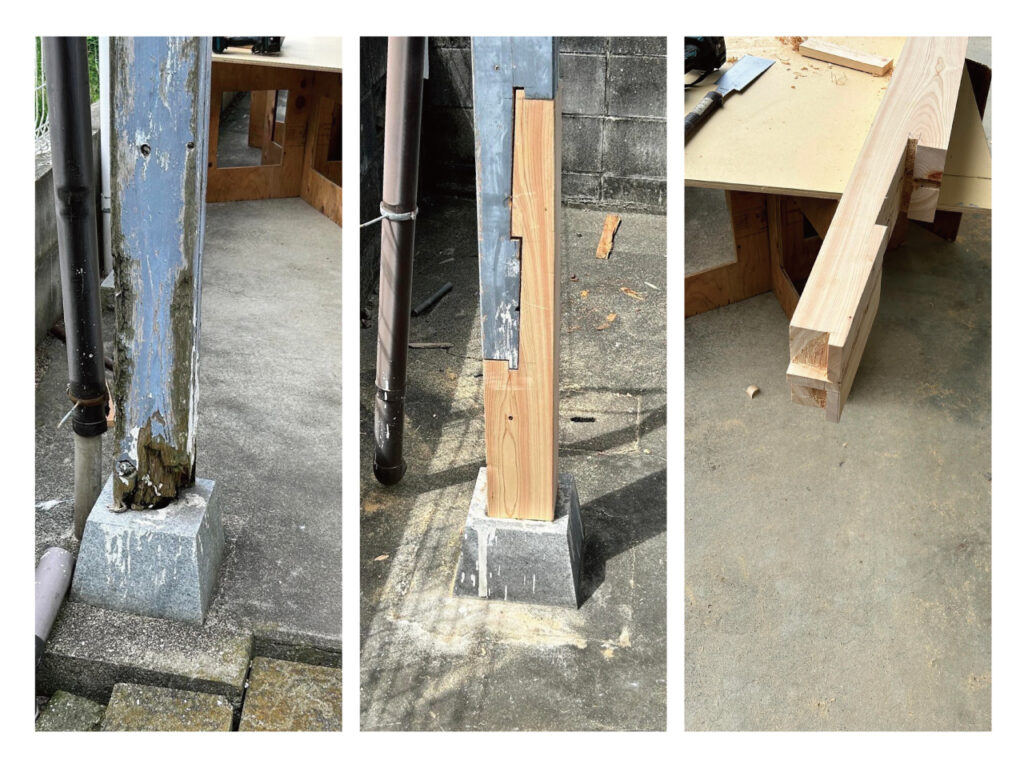
For us, traditional-style house owners, it is difficult to find craftspeople who are able to fix their homes with original methods and materials. Even if we are lucky to find ones in action, due to their rarity, both craftspeople and material, the cost tends to become expensive.
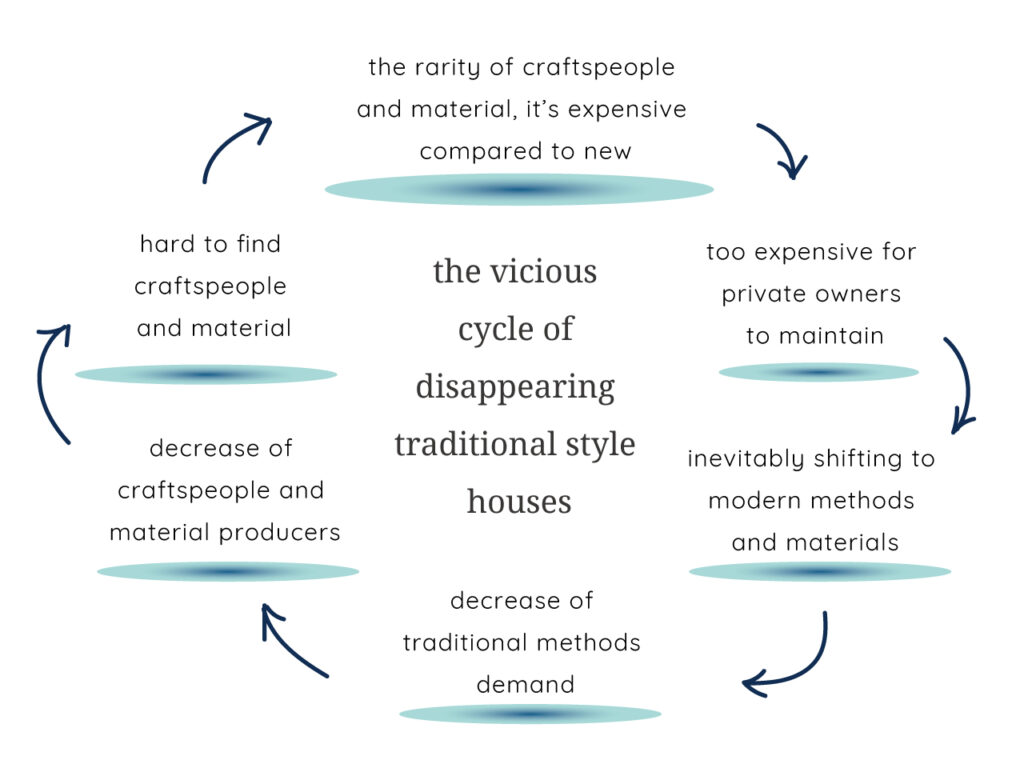
Also, not everyone gets excited about keeping traditional things like I do. Although there is a stream of trends for younger people moving into traditional-style houses and renovating them themselves, it is not a significant trend. And it leads to a topic later (“Attraction Toward New Things”).
The Challenges of Traditional Craftsmanship Transfer and Material Acquisition in Restoration Projects within Shikoku
I have witnessed two examples of the difficulty of reconstructing something traditional or historical with an authenticity-oriented approach here in the Shikoku region of Japan. One is the restoration of a castle tower in Ehime prefecture, and the other is the gate of a Japanese castle in Kagawa prefecture.
It is a local love-filled project that must make locals proud—The Ozu Castle (大洲城), Ozu City, Ehime, Shikoku, Japan
The last castle built in Japan was Sonobe Castle in Kyoto, Japan, in 1869. It was the end of carpenters who knew how to build a castle from scratch in practice base while temples, shrines, and houses kept being built. Put that in your mind: Can you imagine how bold a project was for the people of Ozu to reconstruct the castle tower of Ozu castle?!
Ozu people rebuilt their castle tower from scratch using traditional methods funded by donations! I understand their passion and desire for their castle tower because I was born and raised in a city called Marugame. The city has one of 12 castles with original castle towers, Marugame Castle, which was built in 1660. Castles are symbols of the locals’ history, culture, and identity.
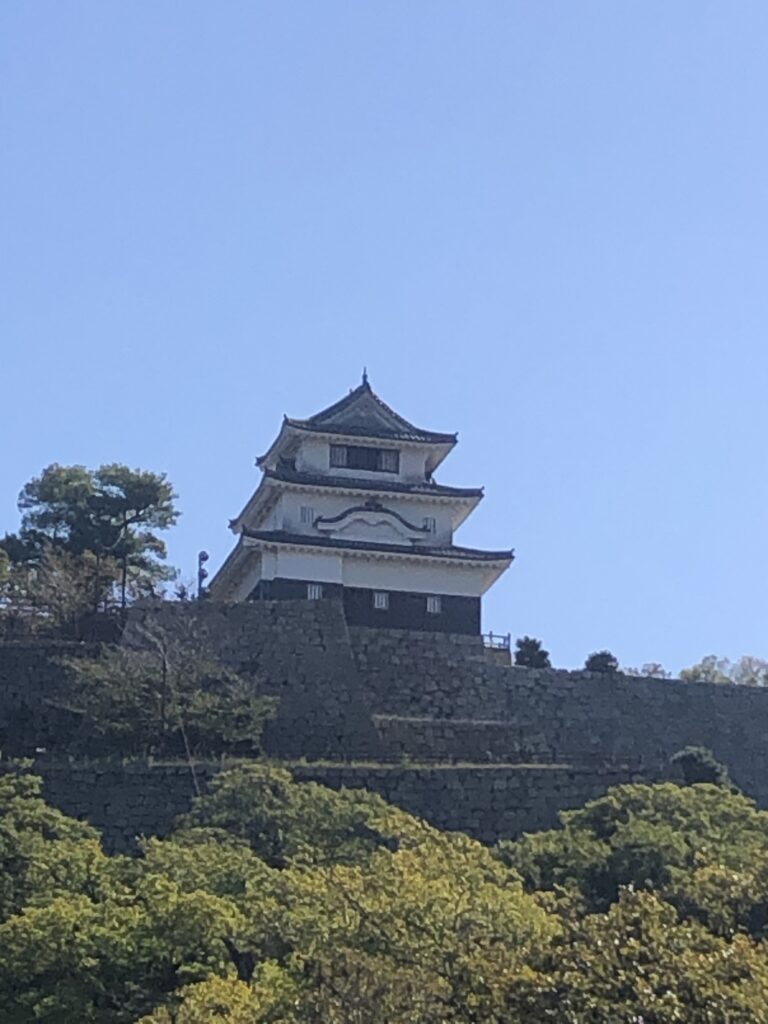
Marugame Castle,
Marugame, Kagawa, Japan
— the model of our symbol mark.
I visited Ozu Castle about 10 years after the compilation of reconstruction. You never get to see a castle tower newly built. I’ve been to my local castle and gone up the tower countless times, but it’s centuries old. Unfortunately, I noticed a few things. Gaps and cracks were showing already. It happens when you use wood without drying it enough.
Do not get me wrong. I am not saying that they did a bad job. They did a wonderful, meaningful job restoring the tower. As I mentioned in the first section, it is a matter of rarity to get materials. I assume that because of the budget and time, they had to use the wood in the tower. I am sure all the carpenters and craftspeople involved in the project wanted to use naturally well-dried wood like any other centuries-standing castle.
A new approach?!—Sakura-gomon Gate (桜御門) in Tamamo/Takamatsu Castle. Takamatsu citiy, Kagawa, Shikoku, Japan.
According to the Takamatsu City Hall Official Website, “The Sakura-gomon Gate, recreated through the collection of restoration evidence and research studies aimed at utilizing cultural assets and the fusion of traditional skills with modern construction methods.”
Takamatsu is the city where KoLe is based. I decided to check it out.
“So, this is the city’s term for ‘the fusion of traditional skills with modern construction methods,’” I groan dissapointedly. For a person who has grown up playing and seeing the Marugame castle, the gate seemed a little bit theme park-like. Ever since that day, I have been thinking about why the gate seemed to lack authenticity. I know it is not because it’s new, but something else, compared to the gates of Marugame Castle…
The castle in Takamatsu was burnt during WWII. I support the restoration activity. I am not saying they did a bad job. Again, it has to be a matter of budget and time, as well as craftspeople and materials.
What do these projects tell us?
Both restorations were based on thorough research, yet despite the effort and willingness, their results are seemingly not the same as the original. In these two castle cases, we must understand the fundamental differences between now and the time castles were originally made. Today, it is hard to find sponsors like castle lords back then. When the locals try to finance the project by donation and/or local government budget within the area, it is nearly impossible to fund them enough to reconstruct something in an authenticity-orientated approach.
Also, these projects might have proven what I always say through KoLe from time to time.
“When a craft vanishes, it takes the craft itself and its materials, tools, knowledge, and skills, all lost to time. Craftsmanship has to be kept alive on a practice and industry basis. Keeping records and preserving them in a museum way doesn’t work if we might need the craftsmanship in use in the future.”
KoLe SHIKOKU, Japan
To preserve our local heritage craftsmanship in practice, KoLe works with different kinds of heritage crafts artisans who are independent and flexible to create something outside of their original heritage crafts. This way, we can offer to produce artisanal items that match your needs and lifestyle.
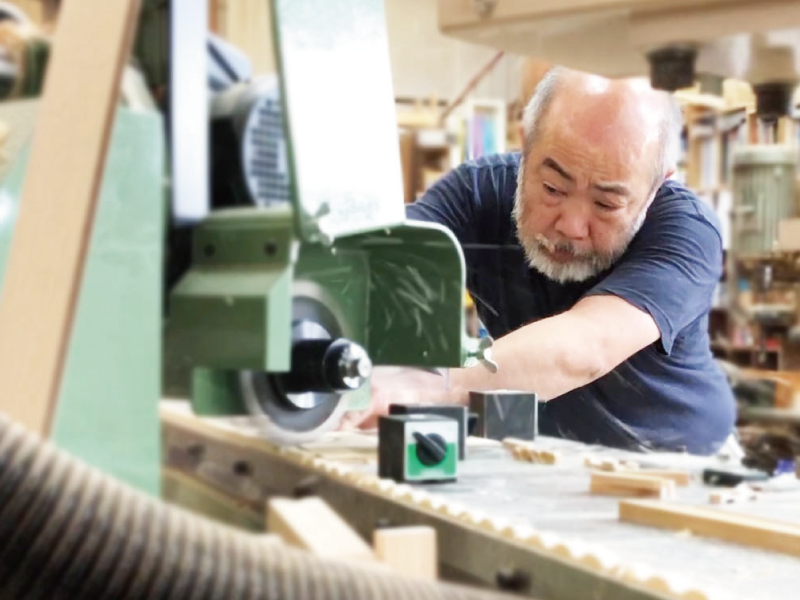
For example, our collaborating Kude-Shoji craft artisan, Takashi Morimoto, is an artisan from the architecture field. His original heritage craft is creating Shoji screen/sliding doors, but he also creates earrings, bags, and furniture with his heritage artisanal skills. For more information and to see our unique artisanal items, visit our website: Site Top > Product or Crafts and Art.
Attraction Toward New Things
Without a doubt, local people’s everyday lives and demands must be prioritized over visitors’. To be very honest with you, as a person who spends a few weeks a year in a century-old house (my parent’s house), living in a traditional house is not necessarily always comfortable or convenient, considering our modern lifestyle. So, you cannot give locals a hard time shifting to new, modern, efficient, and manageable houses. I also wish I could build a more comfortable house for my mother and I live in the old one.
Regardless of functions, humans always seek something new. It is not a bad thing at all. It keeps us going. On the other hand, it is hard for us to notice values or uniqueness in things that have been around us for a long time. I call it “ubiquitous blindness.”
Something has been around for centuries, and people automatically assume it will be there for other centuries without taking any actions, assuming that something is the same everywhere because people see it everywhere within their living area or simply acknowledge something as “just old.”
It is not a matter of good or bad. As long as we are humans, we cannot avoid the ubiquitous blindness. My point here is it is hard for local people to see the value you see in the area.
Your Voice Becomes Wakeup Call—the role of international visitors
In this article, we covered:
- What forms the exotic atmosphere we expect in travel destinations
- Who maintains the scenery
- The difficulties to maintain, especially in Japan
- Examples of complete restoration projects in modern-days
- The possible reasons why it is hard to reconstruct something lost centuries ago
- The reason why it is hard for the locals to recognize their local uniqueness and heritage value
As in the previous section, it is difficult for the locals to see what is unique and worth saving in their culture. We can see them only when the outside voices become big enough to reach the locals’ ears. The voices of those who visited somewhere to seek something different from where they were from—Your voice.
Financing restoration within the area might be impossible, but if it were opened to the world, we might have the chance. Even for private residential buildings, if your voices were heard and the demand for traditional craftspeople increased, maintenance might become easier than now. Better yet, if the local economy increases through tourism, the locals will recognize what needs to be kept, and change will progress.
Preserving authentic exotic atmospheres and cultures should not only be the responsibility of the locals. I hope the world changes to a place that acknowledges that keeping someone’s culture is an issue we work together on internationally.
For your voice to be heard, the next time you visit somewhere, share on social media how you were positively amazed by different and traditional cultures or aesthetics. If you have a chance to talk to local people, tell them what you like about their hometown.
If you ever visit Shikoku and would like to share what you saw and how you saw it, share it with me so that I can share it with our community on our social media or blog with your account mentioned. You can reach me via the contact form on our website or by DMing on social media.
Now, I will let you go with a set of questions.
In your country, are there any landscapes that are disappearing?
What are they?
I would appreciate it if you could share the questions and the link to this article on your social media. If you do, please let me know so that I can visit your account.
*How to contact me: Use the contact form on our website and DM on social media. For MiseNoMa members, you know my email address :).
This article got longer than I anticipated, so thank you for reading till the end.
Did you like the topic, article, or what we do?
Let’s connect!
Be our MiseNoMa members:
You will be invited to members’ exclusive one-on-one online events and receive once/twice updates.
Your support is much appreciated!
Any topic suggestions?
Your insight is valuable, so do not hesitate to tell us what you would like to know about.
Do you know anyone who’d be interested in this article?
Please let the person/people know.
Thank you for your time.

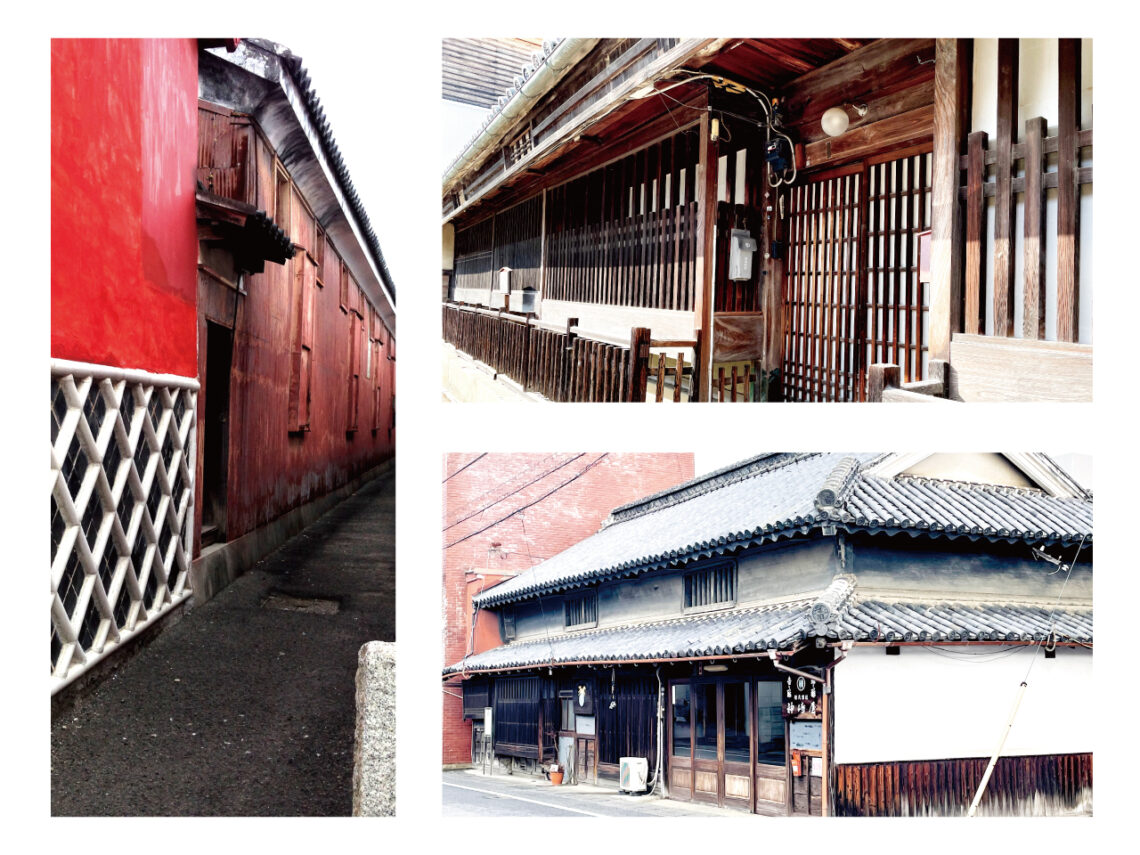
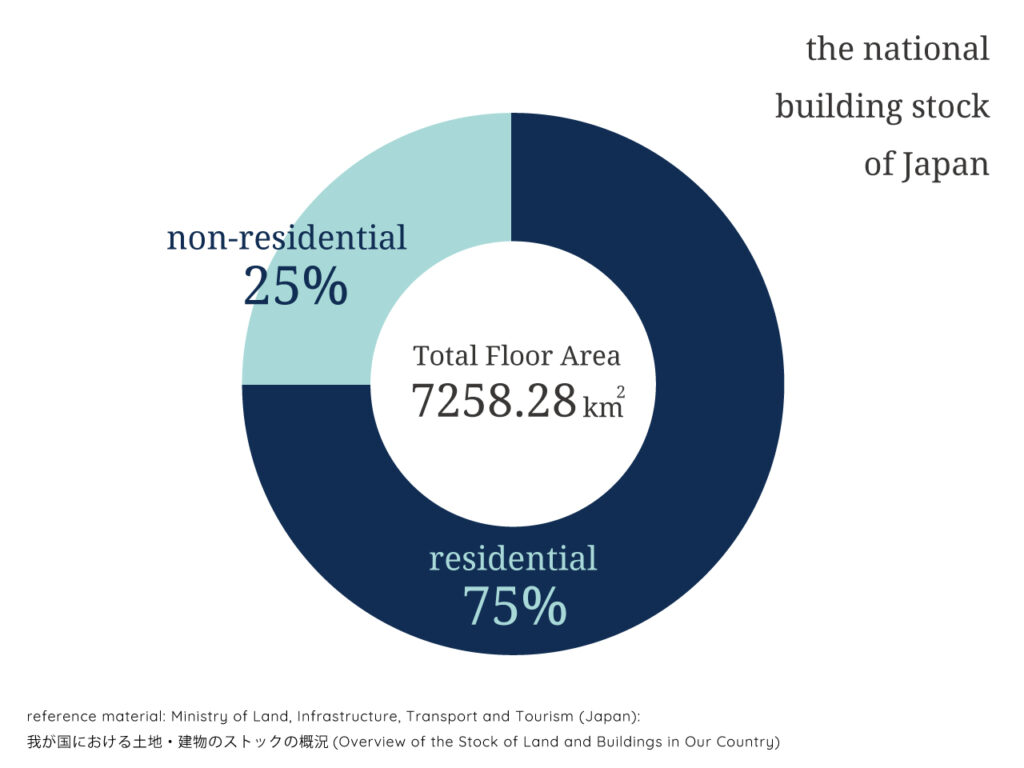



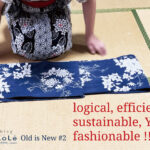

Comments by satoko